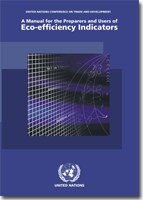
This manual presents the results of ISAR´s work to extend the conventional accounting model and to link environmental performance with financial performance.
The precise correlation between the improved environmental performance of an enterprise and its bottom line is extremely difficult to prove because of the many factors that can affect profits. However, the concept of ecoefficiency, where increased profits are achieved under conditions of declining environmental impact, demonstrates such a link.
Despite the practical usefulness of eco-efficiency indicators, their construction and use are highly problematic.
This manual presents a method by which environmental and financial performance indicators can be used together to measure an enterprise´s progress in attaining eco-efficiency or sustainability.
The manual provides detailed explanations and examples for the preparers and users of eco-efficiency indicators so that they can produce internally consistent environmental and financial information, thus improving the quality of environmental reporting and stakeholder satisfaction.
The purpose of the manual is threefold:
-
To give guidance on how to define, recognize, measure and disclose environmental and financial information as specified within the traditional accounting and reporting frameworks;
-
To improve and harmonize the methods used so that enterprises are able to report eco-efficiency indicators in a standardized format so that they are meaningful to decision makers and can be compared across enterprises;
-
To complement and support existing reporting guidelines (e.g. the UNSustainability Reporting Guidelines developed by the Global reporting initiative (GRI));




